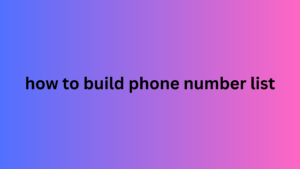When it comes to improving search engine rankings, using long-tail keywords effectively can help websites capture niche traffic and enhance visibility. An often-overlooked yet powerful SEO technique for ranking long-tail keywords is optimized anchor text. Anchor text is the clickable text that forms the hyperlink, and when used correctly, it can contribute significantly to a site’s SEO strategy. Here’s how you can leverage optimized anchor text to rank for long-tail keywords.
Understanding Long-Tail Keywords
Long-tail keywords are longer, more specific phrases that often have lower search volume but higher conversion rates. These keywords cater to users who are closer to making a purchase or decision how to build phone number list, meaning that they tend to have less competition. For example optimized anchor text , instead of targeting a broad keyword like “digital marketing,” a long-tail keyword could be “best digital marketing services for small businesses.” These keywords allow you to target a more specific audience, increasing the chances of driving relevant traffic to your website.
The Role of Anchor Text in SEO
Anchor text is critical for helping search engines understand the context of the linked content. Search engines like Google rely on anchor text to assess the relevance and quality of the target page. When anchor text is optimized why anchor text is key to ranking for long-tail keywords, it provides valuable information about the content being linked to, which can improve rankings for the associated keywords. This is particularly important when optimizing for long-tail keywords, as using precise and relevant anchor text can directly influence how well the page ranks for those specific queries.
How to Optimize Anchor Text for Long-Tail Keywords
Use Exact Match Anchor Text
Using exact match anchor text for long-tail keywords is one of the most effective strategies for ranking. For instance, if you’re trying to rank for the keyword “best digital marketing services for small businesses,” using the exact phrase as the anchor text for internal or external links can significantly help. However, overuse of exact match anchor text may look spammy to search engines optimized anchor text , so balance is key.
Incorporate Variations and Synonyms
Google’s algorithms are smart enough to recognize variations of the same keyword. Instead of always using the exact long-tail phrase, incorporate synonyms or related terms into your anchor text. For example, for the long-tail keyword “affordable web design for startups,” you could use variations like “cost-effective web design services” or “budget-friendly website design for startups.” This practice diversifies your anchor text profile, making it more natural and SEO-friendly.
Contextual Relevance
Ensure that the anchor text is contextually relevant to the page it is linking to. If your anchor text is “learn more about SEO for local businesses phone number es,” then it should link to a page specifically addressing SEO strategies for local businesses. Irrelevant or misleading anchor text can harm your rankings and user experience, so relevance is key to optimizing for long-tail keywords.
Avoid Over-Optimization
While it’s tempting to stuff anchor text with keywords to improve rankings, over-optimization can backfire. Google penalizes sites for unnatural linking practices, such as using the same keyword-rich anchor text repeatedly across multiple links. Focus on creating a natural linking structure with a variety of anchor texts, including branded terms, generic terms optimized anchor text , and long-tail keywords, to avoid penalties.







